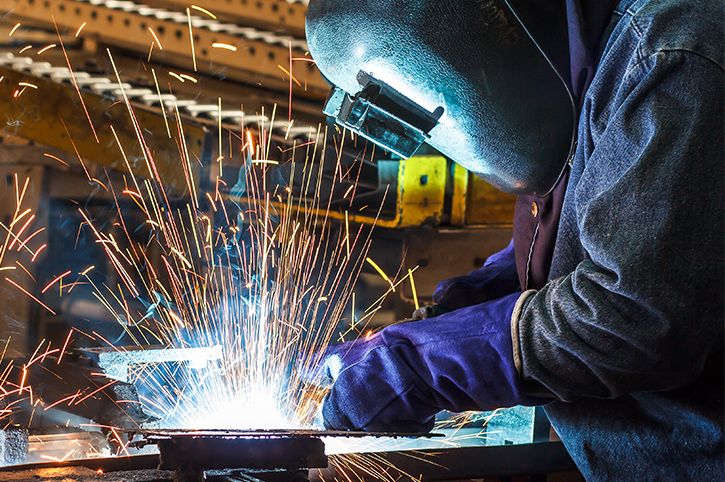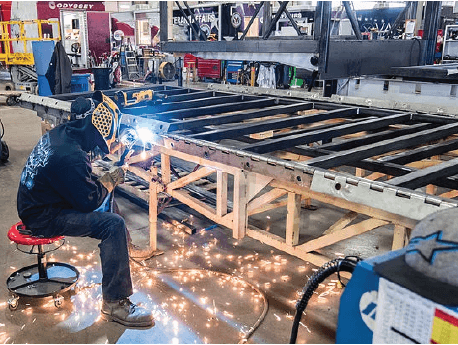Frequent causes of weld misalignment and Belgrade Fabrication’s tips
Wiki Article
Usual Welding Repair Issues and Exactly How to Address Them Properly
Welding repairs usually experience a variety of problems that can threaten the stability of the end product. Usual problems consist of inadequate penetration, porosity, and imbalance, among others. Each problem offers one-of-a-kind difficulties that call for details approaches for resolution. Understanding these concerns is essential for welders intending to enhance their abilities and results. This discussion will certainly explore these typical welding repair service concerns and effective approaches to address them.Inadequate Infiltration
Poor penetration happens when the weld steel fails to totally fuse with the base product, causing weak joints and prospective architectural failures. This issue usually comes from inadequate warmth input, incorrect electrode angle, or incorrect welding rate. Welders may run into insufficient penetration because of a mistake of the required criteria for a specific material thickness or type. Additionally, contamination on the base material's surface area can impede effective bonding, exacerbating the trouble. To resolve insufficient infiltration, welders need to assure appropriate setups on their tools and maintain a tidy work surface area. Routine evaluation of welds is recommended to identify any deficiencies early, enabling prompt adjustments and the prevention of jeopardized architectural stability in welded settings up.Porosity
Porosity is a typical flaw in welded joints that materializes as little gas bubbles entraped within the weld metal. This issue can endanger the stability of the weld, leading to lowered strength and potential failure under stress and anxiety. Belgrade. Porosity generally arises from contamination, dampness, or inappropriate welding methods, which enable gases to get away right into the molten weld swimming pool. To resolve porosity, welders ought to assure correct surface area prep work, maintain a clean functioning atmosphere, and make use of ideal welding specifications. Additionally, picking the ideal filler material and protecting gas can minimize gas entrapment. Routine examination and testing of welds can assist recognize porosity early, guaranteeing timely restorative actions are taken, thereby protecting the top quality and reliability of the bonded structureImbalance
Misalignment in welding can develop from different variables, including improper setup and thermal growth. Recognizing the root triggers is necessary for efficient resolution. A number of correction methods are readily available to realign components and ensure structural stability.Sources of Imbalance
Welding misalignment often comes from a selection of underlying concerns that can compromise structural integrity. One main cause is inappropriate fit-up of components before welding, which can bring about voids and uneven surfaces. Variants in thermal expansion throughout the welding procedure can also result in distortion, especially if the materials being signed up with have various coefficients of development. Furthermore, insufficient fixturing and clamping may stop working to hold parts firmly in location, leading to motion throughout welding. Badly conserved equipment, including welding devices and devices, may present variances in the weld grain, additional adding to imbalance. Lastly, operator error, coming from inadequate training or experience, can also play a substantial role in developing misaligned welds.Improvement Methods Available
Dealing with misalignment effectively calls for a mix of rehabilitative techniques tailored to the certain issues handy. One usual approach is making use of jigs or fixtures to hold elements in the proper placement during welding, making sure regular alignment. Furthermore, preheating the products can help minimize distortion and boost fit-up. For substantial misalignment, mechanical realignment strategies, such as making use of hydraulic jacks or clamps, can be used to remedy the position before welding. Post-weld warmth treatment might also be required to relieve anxieties brought on by misalignment. Lastly, cautious evaluation and modification during the setup phase can avoid imbalance concerns from becoming substantial problems, promoting a smoother welding procedure and boosting overall structural integrity.Distortion
Distortion is an usual obstacle in welding that can arise from numerous elements, including unequal cooling and heating. Recognizing the sources of distortion is important for executing efficient avoidance techniques. Resolving this concern not only enhances structural integrity however likewise enhances the general top quality of the weld.Reasons of Distortion
When subjected to the extreme warm of welding, materials usually undergo changes that can bring about distortion. This sensation primarily emerges from thermal expansion and tightening throughout the welding procedure. As the weld area warms up, the material broadens; upon cooling, it acquires, which can produce inner stress and anxieties. Additionally, unequal heating throughout a work surface can exacerbate these stress and anxieties, causing warping or bending. The kind of material additionally plays a significant function; steels with differing thermal conductivity and coefficients of development may respond in different ways, causing unpredictable distortions. Additionally, poor joint design and poor fixturing can add to misalignment throughout welding, enhancing the likelihood of distortion. Understanding these reasons is necessary for effective welding repair and prevention approaches.Avoidance Techniques
Reliable avoidance techniques for distortion throughout welding emphasis on controlling warm input and ensuring proper joint layout. Keeping a consistent warmth input assists to reduce thermal expansion and contraction, which can lead to distortion. Making use of techniques such as pre-heating the workpiece can likewise decrease the temperature level slope, advertising consistent heating. Furthermore, choosing ideal joint styles, such as T-joints or lap joints, can enhance security and decrease anxiety focus. Carrying out proper fixturing to secure the workpieces in area additionally help in maintaining placement throughout the welding procedure. Staggered welding series can distribute warm more equally, stopping local distortion. By applying these strategies, welders can considerably lower the possibility of distortion and improve the total top quality of their welds.Splitting
Splitting is an usual issue experienced in welding fixings, typically resulting from various elements such as incorrect cooling rates, material option, or insufficient joint preparation. The occurrence of splits can significantly jeopardize the honesty of the weld, bring about prospective failures throughout procedure. To resolve this problem, welders must initially examine the root creates, making certain that materials work and appropriately selected for the specific application. Additionally, managing the cooling rate throughout the welding process is essential; quick cooling can induce anxiety and lead to breaking. Appropriate joint layout and prep work likewise add to lessening the risk. Implementing these methods can enhance weld quality and toughness, ultimately lowering the chance of splitting in ended up weldments.
Insufficient Blend
A significant problem in welding fixings is incomplete blend, which happens when the weld metal does not sufficiently bond with the base material or previous weld passes - Montana Mobile Welding and Repair Belgrade Fabrication. This flaw can lead to weaknesses in the joint, potentially endangering the integrity of the bonded framework. Elements adding to insufficient blend include inadequate warm input, improper welding technique, and contamination of the surfaces being joined. To resolve this problem properly, welders should guarantee appropriate pre-weld cleaning and surface area prep work, along with readjust their welding parameters to accomplish sufficient penetration and fusion. Routine assessment during the welding process can also aid recognize insufficient blend early, permitting timely rehabilitative actions to enhance the total top quality of the weldOverheating
While welding repair services can boost architectural integrity, overheating offers a considerable difficulty that can cause material destruction. Excessive heat throughout welding can change the mechanical residential properties of steels, causing minimized strength, raised brittleness, and bending. This sensation is particularly vital in high-stress applications where structural reliability is extremely important. Determining overheating can include visual inspections for staining or distortion, in addition to checking temperature level throughout the welding process. To reduce the threats connected with getting too hot, welders should utilize ideal methods, such as managing warm input, readjusting travel rate, and utilizing appropriate filler products. Additionally, carrying out pre- and post-weld warmth therapies can help restore material properties and improve the total top quality of the fixing, making sure long-lasting efficiency and safety.Regularly Asked Inquiries
What Are the Common Indicators of a Welding Defect?

Just How Can I Check My Welds for Quality?
To test welds for top quality, one can utilize aesthetic examinations, ultrasonic testing, and radiographic techniques. Each strategy guarantees architectural integrity, recognizes problems, and confirms adherence to defined standards, ultimately improving the reliability of the welded joints.What Security Preventative Measures Should I Take While Welding?
When welding, one ought to focus on safety and security by wearing appropriate individual protective tools, making sure appropriate air flow, securing flammable materials away, preserving a tidy workspace, and understanding surroundings to avoid injuries and mishaps.Can I Fix a Weld Without Renovating the Entire Joint?
Repairing a weld without remodeling the entire joint is possible, relying on the damages (Welding). Strategies such as grinding, adding filler material, or utilizing a welding process can effectively resolve particular defects while preserving the bordering frameworkWhat Tools Are Vital for Efficient Welding Services?
Crucial tools for effective welding repair work consist of a welding machine, wire brush, grinder, safety gear, clamps, and filler materials. Each tool plays an important role in making sure high quality and safety throughout the repair service procedure. Porosity usually occurs from contamination, wetness, or incorrect welding methods, which enable gases to get away into the liquified weld swimming pool. Poorly kept equipment, including welding equipments and devices, may present disparities in the weld bead, additional adding to misalignment. When subjected to the intense warmth of welding, materials commonly undertake adjustments that can lead to distortion. Splitting is a typical concern experienced in welding repair work, typically resulting from various aspects such as incorrect cooling rates, product choice, or inadequate joint get more info preparation. A considerable concern in welding repair services is incomplete blend, which takes place when the weld metal does not effectively bond with the base material or previous weld passes.Report this wiki page